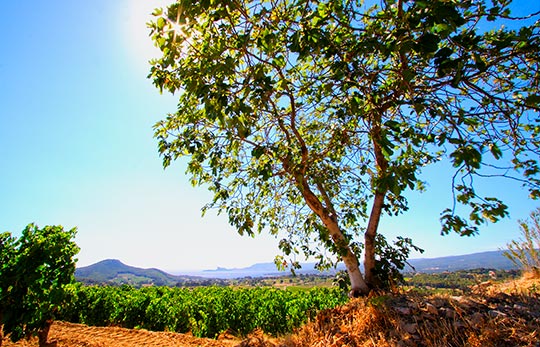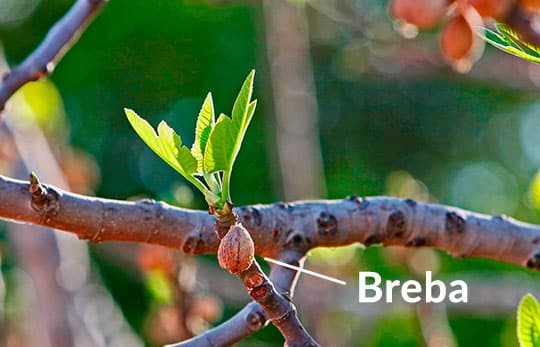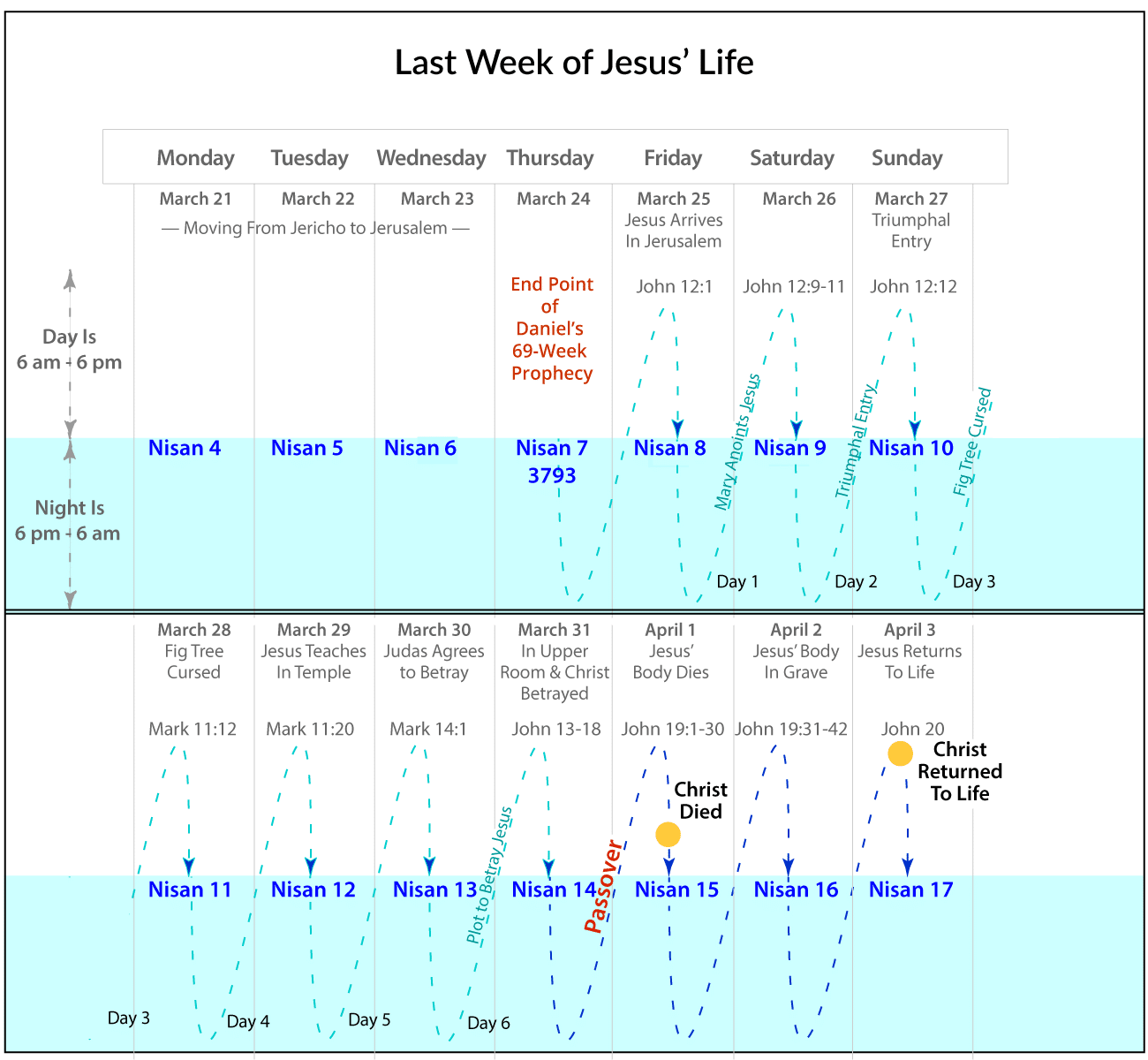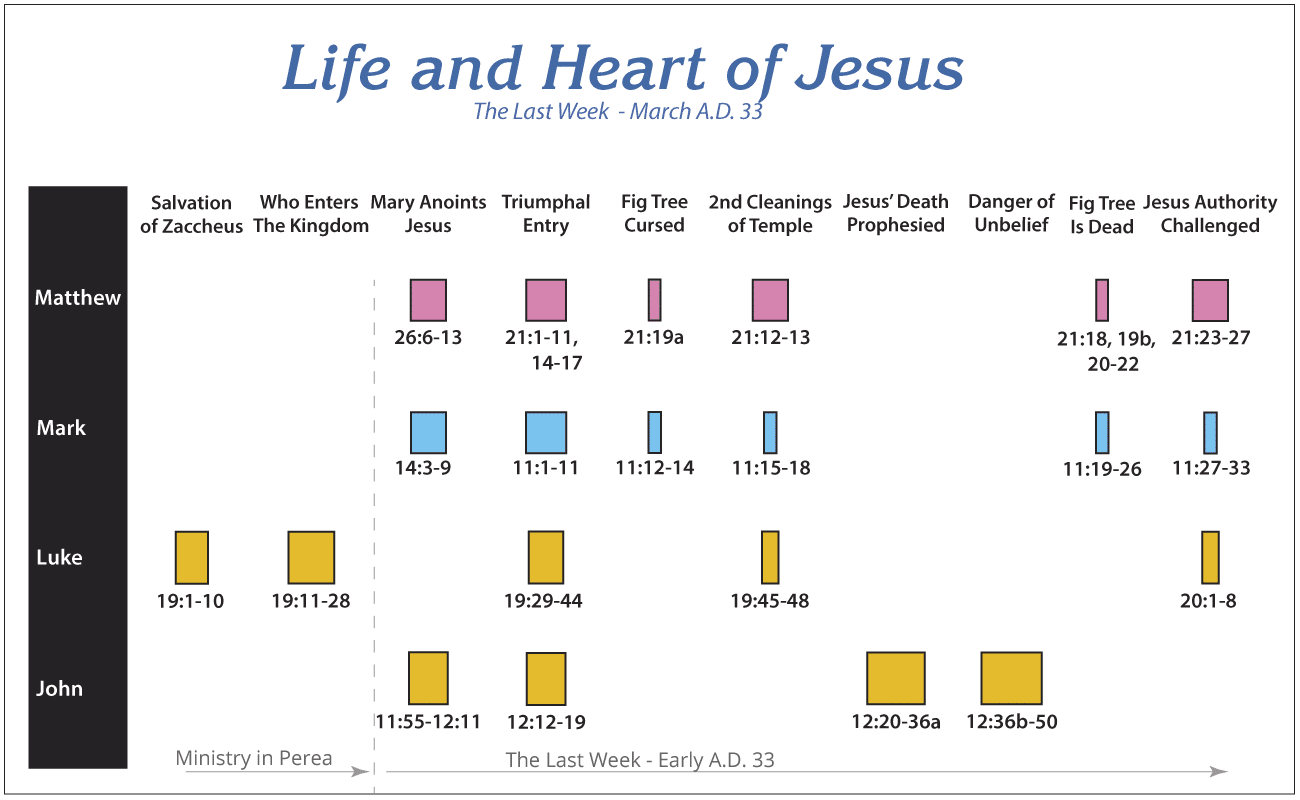
Fig tree in Vineyard
It is Monday, March 28, A.D. 33 or Nisan 11 in the Hebrew calendar. Yesterday was the Triumphal Entry of Christ. Yesterday, Jesus received honor and blessing from a crowd along the road from Bethany to Jerusalem. Yesterday, the blind and the lame came to Him at the temple and were healed. The people of Jerusalem were very interested in Him, but they were not committed to Him. It was a wonderful day for Christ because He was honored as the Messiah, the King of Israel. It was also a wonderful day because two prophecies were fulfilled (Psalm 8:2; Zechariah 9:9). The prophets had predicted that day. It was also a day of criticism from the chief priests and scribes. Yet, that must have been encouraging for it revealed they were being motivated to kill Him. However, the day was also a reminder that their rejection of Him would result in the destruction of Jerusalem and a massive slaughter of the people of Jerusalem (Luke 19:41-44). It was a day of joy and weeping. The Father’s plan for His sacrificial death for the forgiveness of our sins was being executed. His human body would die on Friday during Passover. Then at the end of the day He and the disciples walked back to Bethany for the night. Our study begins on Monday morning, March 28, A.D. Our study is about a fig tree (Matthew 21:12-13, 18-19; Mark 11:12-21; Luke 19:45-48). We will follow Mark’s gospel in this study.

Symbol of Spiritual Deadness
The gospel of Mark provides us with the most complete description of the events about the fig tree. So, we will follow Mark’s account.
On the next day, when they had left Bethany, He became hungry.Seeing at a distance a fig tree in leaf, He went to see if perhaps He would find anything on it; and when He came to it, He found nothing but leaves, for it was not the season for figs. Mark 11:12-13 (NASB)
Mark 11:12-13 captures the early events on Monday morning, the day after the Triumphal Entry. We are told that after Jesus left Bethany, He became hungry. Verse 15 will tell us that Jesus and the disciples were headed for Jerusalem, which was about two miles from Bethany. So somewhere along that two mile walk, He became hungry and saw a fig tree in leaf. Verse 13 states that Jesus saw a fig tree at some distance and went to it hoping to find some fruit. But when He arrived, He found the tree only had leaves. Then we are told that it was not the season for figs.
This is a confusing passage for anyone who is not familiar with fig trees in the land of Israel. So, we need to understand two points to unscramble what happened. First, the time of the year was 28 March A.D. 33. The winter season was almost over. That helps us to understand some plants and trees were beginning to grow. Second, W. E. Shewell-Copper reveals that “baby fruit buds” on the fig tree native to Israel would usually appear in February before the leaves did. Then the fruit would ripen in May and June. He wrote,
The normal winter figs ripen in May and June and the summer figs in late August and September. Sometimes, one crop overlaps the other. The baby fruit buds are usually seen in February before the leaves appear in April each year.[1]
These fig trees are called Ficus Carica. The baby fruit buds W. E. Shewell-Copper refers to are called brebas.[2] A breba grows out of the wood of the tree from the previous year’s growth. Photographs and videos document that breba can grow on a fig tree branch without leaves being present.[3] So, the baby fruit can appear before the leaves. The first crop, called the breba crop, occurs relatively early in the year on the previous year’s growth.[4] Then later in the spring, the first crop of figs ripen.
In culinary markets, especially in Spain and Colombia, Brevas are regarded as a delicacy due to their limited availability and are valued for their unpredictable, varying flavor.[5]
These baby figs can be present in March with or without leaves on the branches. This means that when Jesus saw the leaves, it would have been reasonable for Him to expect fruit such as breba. So when Mark said, “it was not the season for figs,” it appears that he was reminding the reader that the baby fruit should have been available, but the full grown figs would come in May and June. The leaves that Jesus saw revealed that at least breba should have been on the branches, and the full crop of figs would come later. Hosea 9:10 and Micah 7:1 refer to the breba.
Then verse 14 says that Jesus cursed the tree.
He said to it, “May no one ever eat fruit from you again!” And His disciples were listening. Mark 11:14 (NASB)
The Greek word that is translated as “ever” is composed of three Greek words which literally reads as “into the ages.” That is, Jesus said, “Not into the ages” will anyone eat fruit from you again. It was a curse upon the tree. This would result in the tree not producing any fruit. The tree was not functioning correctly already. It should of had breba in March. Surprisingly, we are not told if the disciples asked Jesus why He did that. I am sure the disciples were curious! You may wonder why Jesus cursed the tree. Why did Jesus curse the fig tree? We will discover later. But for now, we will have to wait.

Acceptance of Spiritual Deadness
So, Jesus cursed the fig tree somewhere on the Mount of Olives as they walked along the road from Bethany toward Jerusalem. Verse 15 tells us they finally arrived in Jerusalem, and entered the temple.
Then they came to Jerusalem. And He entered the temple and began to drive out those who were buying and selling in the temple, and overturned the tables of the money changers and the seats of those who were selling doves; and He would not permit anyone to carry merchandise through the temple. Mark 11:15-16 (NASB)
Since the primary entrance to the temple was from the east, most likely Jesus and the disciples entered through the eastern gate and walked onto the Court of the Gentiles. Before they walked onto the Court of the Gentiles, they would have seen people treating the temple like a common road by taking a shortcut through the court to a road leading to the Mount of Olives. Later, the Mishnah prohibited such behavior.[6]
They did not see worshipers solemnly bringing their sacrificial animals to be offered on the golden altar. Instead, Jesus saw a money-exploitation-scheme. He saw an outdoor market that took advantage of travelers from great distances who came to worship at Passover. Rather than bringing animals with them from great distances, the travelers would arrive at the temple and buy animals supposedly guaranteed to be spotless and acceptable for sacrifice. Obviously, no traveler would want to bring an animal only to learn that the priests claimed it was not perfect. So, supposedly these animals were sold at the temple as a service. The scheme that Annas and his sons had developed made them wealthy.
Alfred Edersheim, a converted rabbi, states the court of the Gentiles had bazaars. They were owned by the high priest Annas.[7] Sometimes the bazaars have been called the bazaars of the sons of Annas.[8] Annas and his sons sold franchises to merchants who would raise the animals for Passover and then sell them. Then Annas and his sons would also take a percentage of the sales. But in order for the travelers to buy the animals, they had to convert their Roman money into the temple coinage known as the Tryian shekel. Outrageous prices were charged to exchange the Roman currency into Tryian currency. Annas and his sons took a percentage of the charge. Since everything had to paid in the Tryian coin, we can only imagine how wealthy this made Annas and his family.
John 2:14 tells us that sheep and oxen were being sold the first time Jesus cleansed the temple. This second time we are told they were selling doves. Apparently, John did not mention the doves and Matthew did not mention the sheep and oxen. For both would have been required. That would mean large numbers of animals would have been in the Court of Gentiles and doves in cages. We can only imagine the noise that was created by the people and the animals. While Scripture does not say, it is possible the merchants were shouting out prices and offering a better deal for your sacrifice. They had turned the temple into a place of a wicked business.
The cold hearts of the high priest and sons are obvious. But it is even worse when we realize they also sold doves to the poor. Doves were the offerings that our God allowed the poor to bring. Yet, the poor were exploited too! We can imagine the noise of the very large crowd buying, the exploiters selling, and the sound of animals. The smell of the animals may have been irritating. This was not a place of worship. It was spiritualized-robbery.
So, we rejoice when we read in verse 15 that Jesus drove everyone out of the temple. The Greek word for “drive out” is ekballo. It literally means to “throw out.” Obviously, Jesus did not pick up the people and throw them out. That is why the NASB and other major Bibles say “drive out.” But the message is that Jesus forcefully drove them out. He was so forceful that He overturned tables and seats. Any money that was on the table would have scattered over the floor.
Jesus did not allow anyone to carry merchandise through the temple. When we are told that Jesus would “not permit” them to carry anything through the temple, the Greek tense for “no permit” is in the imperfect tense. That is, He was repeatedly stopping them. All together we are left with a very vivid picture of Jesus moving about and very forcefully preventing anyone from taking anything out of the temple or moving through the temple. Too bad we do not have a video of the scene!
We can be confident the chief priests and scribes were horrified to see Him do this. They lost money. Jesus interfered in their annual money-making bazaars. Since Passover was just days away, millions of people would have been present. This was the biggest money-making event of every year, and Jesus was interfering. The chief priest and his sons had turned what should have been the high-spiritual event of the year into a crass business. Luke 16:14 has already told us that the Pharisees loved money. So if we wrap all of this together, we understand the Jewish religious leaders must have been furious. They hated Jesus for so many reasons.
Rebuke for Spiritual Deadness
Verse 17 says,
And He began to teach and say to them, “Is it not written, ‘MY HOUSE SHALL BE CALLED A HOUSE OF PRAYER FOR ALL THE NATIONS’? But you have made it a ROBBERS’ DEN.” Mark 11:17 (NASB)
Jesus combined two verses together. The first verse is Isaiah 56:7,
For My house will be called a house of prayer for all the peoples. Isaiah 56:7 (NASB)
The message of Isaiah 56:7 is that the temple was not supposed to be a place of business, a place where the chief priests and scribes became wealthy. They made it difficult for the poor and average citizen to worship at the temple. Instead of being a place to make money, it was supposed to be a place where people prayed to the one and only God. The context of Isaiah 56 also describes Gentiles coming to the temple in Jerusalem during the millennial kingdom. That is, Gentiles and Jews both will be welcomed in Yahweh’s temple in the millennial kingdom temple. It is to be a place of worship and prayer, not a place for pastors and clergy to become wealthy. He said all of this while standing in the outer court called the Court of the Gentiles. We can be confident that the Jewish religious leaders missed that point, and that their prayers were not heard because of their sin (Psalm 66:18).
The last part of the quote is from Jeremiah 7:11. This passage is also about Yahweh’s temple.
Has this house, which is called by My name, become a den of robbers in your sight? Jeremiah 7:1 (NASB)
Yahweh declared that His temple had become a robbers’ den before the Babylonian army invaded Jerusalem and burned the city and temple to the ground. Yahweh did that because Israel had abandoned Him and apparently had done the same thing then. It is appalling that these religious leaders were so spiritually bankrupt. They exploited the worshipers who came to celebrate Passover and seek forgiveness for their intentional sins, inadvertent sins, and to offer thanksgivings. But these religious leaders were heartless.
Hearts of Spiritual Deadness
After the chief priests and scribes heard that Jesus had quoted Isaiah 56:7 and Jeremiah 7:11 to the crowd, they were angry. We can be confident they did not like the people hearing the temple was supposed to be a place of prayer and not a place of business. They did not like hearing they were robbers. Luke 19:47-48 describes their response,
And He was teaching daily in the temple; but the chief priests and the scribes and the leading men among the people were trying to destroy Him, and they could not find anything that they might do, for all the people were hanging on to every word He said. Luke 19:47-48 (NASB)
Mark 11:18 adds this,
The chief priests and the scribes heard this, and began seeking how to destroy Him; for they were afraid of Him, for the whole crowd was astonished at His teaching. Mark 11:18 (NASB)
Once again they planned to kill Him. But this time He would die in four days. This occurred on Tuesday, and He would die on Friday. The spiritually dead would murder the One who came to give life. He was the Light of the World, but they were sons of the dark one. The high priest, his sons, the chief priests, and the scribes, including the Pharisees and Sadducees were spiritually dead.
I am sorry to say that there are many religious leaders today who are just as evil as Annas and his sons. They exploit their congregations, including the poor. For them, the church is not composed of the members of Christ’s body, but of financial supporters and customers. Their pulpit ministries are like that of the church in Sardis. Their ministries appear to be alive, but they are actually dead, and those attending have come to believe this is the way church should be. All they have known are ministries centered around a pastor. Some preachers refer to their ministry as “work.” Wow, what an attitude! They view the ministry as work. They go to work each day of the week, including Sunday! The ministry has become a job. They have lost the view that they were serving our Lord God. The ministry had become about their own popularity, personal acceptance, and financial security.
Matthew 23:33 reveals that Jesus told the Pharisees it would be very difficult for them to escape hell. Luke 16:14 states they had become lovers of money. Money was one of the idols in their hearts. Because their hearts were not devoted to God, they were spiritually dead. The temple was dead, and worship in Jerusalem was dead, except in the hearts of the righteous. Jesus was the true Light in a dead city and in a lifeless temple. Does this describe your church— spiritually dead? Are you a attending but are not growing spiritually?
Curse of Spiritual Deadness
Luke 19:47 has already said that Jesus was teaching daily in the temple. He planned to teach and did teach every day as the day of His death came closer. Early in His ministry, Jesus told the disciples that another reason He came was to preach (Mark 1:38), and so He did. He was fulfilling His purpose. He loved the disciples, but He also loved the lost. That is why He came!
Mark 11:19 is the next verse in the gospel of Mark, but it skips the events described in the passage of John 12:20-50. This passage tells us that some Gentiles had asked Jesus a question after the Triumphal Entry. He then proceeded to discuss His death and to present the gospel to them. But in this study, we are going to skip the passage in John 12:20-50 and jump to Mark 11:19-21 so that we can understand what happened next with the fig tree and understand the message of the cursed fig tree.
Mark 11:19 tells us that Jesus and the disciples left the city when it became dark. They may have returned to Bethany.
When evening came, they would go out of the city. Mark 11:19 (NASB)
Mark 11:20 states that in the morning they walked by the fig tree again. Here are verses 20-21,
As they were passing by in the morning, they saw the fig tree withered from the roots up. Being reminded, Peter said to Him, “Rabbi, look, the fig tree which You cursed has withered.” Mark 11:19-21 (NASB)
When Jesus and the disciples saw the fig tree, Peter responded with surprise. He did not expect the fig tree to be withered. Maybe we would have been surprised too! Peter’s response reveals two important facts. First, his surprise reveals that he did not understand the great authority that Jesus had with His simple statement, “May no one ever eat fruit from you again!” Jesus’ simple command turned a fruitless tree into a lifeless tree. They did not yet understand who Jesus was. They did not understand the power to kill the tree was rooted in God the Father. We will learn more about that in the next study.
The second fact that Peter seems to have missed was the meaning of the dead fig tree. In the Old Testament, Israel was pictured as a fig tree (Hosea 9:10; Nahum 3:12). But even without those references, it is obvious the fig tree is like bookends on a bookcase. Jesus cursed the fig tree before He cleansed the temple and rebuked the high priest and scribes, the religious leaders of Jerusalem. Then afterward, they found the fig tree was dead. Jesus did this for a reason. The fruitless fig tree symbolized the spiritual deadness of the religious leaders and the deadness of the temple. Consequently, Jerusalem was spiritually dead too!

Conclusion
As I was studying this passage, it reminded me of the book of Ezekiel. Yahweh repeatedly warned the civil leaders, the religious leaders, and the people to repent of the idols in their hearts. He called them to repent. In Ezekiel He finally told them the Babylonian army was coming to destroy Jerusalem and the temple with fire. He would burn it to the ground. That occurred during the third Babylonian invasion in 586 B.C. It was because they loved the idols of their hearts. They loved to worship at the shrines and high places of gods and goddesses such as Baal, the Asherah, Tammuz, and Moloch. They enjoyed the ritual sex,, the child sacrifices, and having their children walk through the fire of Moloch. Such descriptions make us feel uncomfortable. It is repugnant to us. We react negatively to their behavior. But we should also be horrified at their spiritually dead hearts and the spiritually dead hearts of Annas, his sons, the scribes, and all the other spiritually dead religious leaders. Because of them, Jerusalem the temple and the people were spiritually dead. They proved that in four days when they cheered for Christ’s death. So, the fig tree symbolized the spiritual deadness of religious leaders, Jerusalem, and the temple.
So, are you like that fig tree? Do you look good but have no spiritual fruit? What idols sit on the throne of your heart? The warning in Ezekiel and in this study is that spiritual deadness results in God’s judgment and punishment. That is the message of the parable of the fig tree.
If that is true of you, do what Ezekiel urged the people to do.
Thus says the Lord GOD, “Repent and turn away from your idols and turn your faces away from all your abominations.” Ezekiel 14:6 (NASB)
In Luke 24:46-47 Jesus urged the disciples to preach this message,
“Thus it is written, that the Christ would suffer and rise again from the dead the third day, and that repentance for forgiveness of sins would be proclaimed in His name to all the nations, beginning from Jerusalem. Luke 24:46-47 (NASB)
Forgiveness of sins occurs when a person believes in Jesus and trusts in Him alone for the forgiveness of sins.
Of Him all the prophets bear witness that through His name everyone who believes in Him receives forgiveness of sins.” Acts 10:43 (NASB)
Suggested Links:
Was Jesus unreasonable with the fig tree in Mark 11:13?Life of Christ – events, miracles, teachings and purpose
Mary Anoints Jesus In Bethany — Before His Death
The Triumphal Entry of Christ As King
Jesus Wept — The Destruction of Jerusalem Prophesied
Pharisees Were Angry Over the Wonderful Things Jesus Did